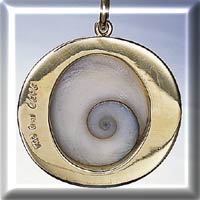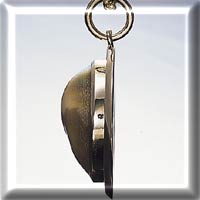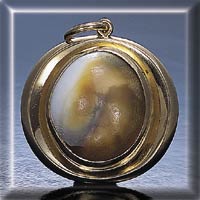







This is also known as Cow's Eye Shila. Some consider this as Eye of Lord Shiva but this we have to date found no evidence for. So far we don't have much on the Gomati chakra or Gomati Silas, what we have is here.
The Gomati River (Gumpti river) meets with Dwarka at the sea so these silas are often connected in this way to Dwarka, and Dwarka silas.
The Gomati is mentioned as one of the sacred rivers in India (Srimad Bhagavatam 5:19:17-18) http://vedabase.net/sb/5/19/17-18/en
etäsäm apo bhäratyaù prajä nämabhir eva punanténäm ätmanä copaspåçanti; candravasä tämraparëé avaöodä kåtamälä vaihäyasé käveré veëé payasviné çarkarävartä tuìgabhadrä kåñëäveëyä bhémarathé godävaré nirvindhyä payoñëé täpé revä surasä narmadä carmaëvaté sindhur andhaù çoëaç ca nadau mahänadé vedasmåtir åñikulyä trisämä kauçiké mandäkiné yamunä sarasvaté dåñadvaté gomaté sarayü rodhasvaté saptavaté suñomä çatadrüç candrabhägä marudvådhä vitastä asikné viçveti mahä-nadyaù.
SYNONYMS
etäsäm—of all these; apaù—water;
bhäratyaù—of Bhärata-varña (India); prajäù—the
residents; nämabhiù—by the names; eva—only; punanténäm—are
purifying; ätmanä—by the mind; ca—also; upaspåçanti—touch;
candra-vasä—Candravasä; tämra-parëé—Tämraparëé;
avaöodä—Avaöodä; kåta-mälä—Kåtamälä;
vaihäyasé—Vaihäyasé; käveré—Käveré;
veëé—Veëé; payasviné—Payasviné; çarkarävartä—Çarkarävartä;
tuìga-bhadrä—Tuìgabhadrä; kåñëä-veëyä—Kåñëäveëyä;
bhéma-rathé—Bhémarathé; godävaré—Godävaré;
nirvindhyä—Nirvindhyä; payoñëé—Payoñëé;
täpé—Täpé; revä—Revä; surasä—Surasä;
narmadä—Narmadä; carmaëvaté—Carmaëvaté;
sindhuù—Sindhu; andhaù—Andha; çoëaù—Çoëa;
ca—and; nadau—two rivers; mahä-nadé—Mahänadé; veda-småtiù—Vedasmåti;
åñi-kulyä—Åñikulyä; tri-sämä—Trisämä;
kauçiké—Kauçiké; mandäkiné—Mandäkiné;
yamunä—Yamunä; sarasvaté—Sarasvaté; dåñadvaté—Dåñadvaté;
gomaté—Gomaté; sarayü—Sarayü; rodhasvaté—Rodhasvaté;
saptavaté—Saptavaté; suñomä—Suñomä;
çata-drüù—Çatadrü; candrabhägä—Candrabhägä;
marudvådhä—Marudvådhä; vitastä—Vitastä;
asikné—Asikné; viçvä—Viçvä; iti—thus;
mahä-nadyaù—big rivers.
TRANSLATION
Two of the rivers—the Brahmaputra
and the Çoëa—are called nadas, or main rivers. These are other
great rivers that are very prominent: Candravasä, Tämraparëé,
Avaöodä, Kåtamälä, Vaihäyasé, Käveré,
Veëé, Payasviné, Çarkarävartä, Tuìgabhadrä,
Kåñëäveëyä, Bhémarathé,
Godävaré, Nirvindhyä, Payoñëé, Täpé,
Revä, Surasä, Narmadä, Carmaëvaté, Mahänadé,
Vedasmåti, Åñikulyä, Trisämä, Kauçiké,
Mandäkiné, Yamunä, Sarasvaté, Dåñadvaté,
Gomaté, Sarayü, Rodhasvaté, Saptavaté, Suñomä,
Çatadrü, Candrabhägä, Marudvådhä, Vitastä,
Asikné and Viçvä. The inhabitants of Bhärata-varña
are purified because they always remember these rivers. Sometimes they
chant the names of these rivers as mantras, and sometimes they go directly
to the rivers to touch them and bathe in them. Thus the inhabitants of
Bhärata-varña become purified.
PURPORT
All these rivers are transcendental.
Therefore one can be purified by remembering them, touching them or bathing
in them. This practice is still going on.
Gomati Shilas are used in placing next to Shaligrams in some special circumstances where the female, shakti is required present if She is not otherwise visible. Thus sometimes they are also called Gopi silas. The Deity of Radha Raman in Vrindavan has some Gomati Silas placed next to Him where the crown that represents Radharani is.
In tantric circles Gomati Shilas are also used as protective kavacha
for children. It is said that they bring wealth and good health.
Gomati, the descended Ganges, meets the sea at Chakra-tirtha Ghat. To take bath where the Gomati meets the ocean is said to offer liberation. If you go out the back entrance of the Dwarkadish Temple, you can see the Gomati River. The temple is located almost at the spot where the Gomati meets the ocean.
The Samudra Narayana Temple (Sangam Narayana) is an imposing temple
at the confluence of the Gomati and the sea. Panchanada Tirtha consists
of five sweet-water wells surrounded by seawater. At Chakra Narayana, Lord
Vishnu was manifested as a stone marked with a chakra on the seashore.
The Gomatiji Temple has an image of the Gomati River in it, said to have
been brought down from heaven by Vasistha Muni.
Intelligence, wisdom and perfect acumen are essentialities for Sucess in life and not only for studies.
Saraswati the Goddess of learning is called Medhaa in the ancient texts and in Jain literature. Still there is a bit of difference in Saraswati Sadhana and Medha Sadhana. The former only brings gain of knowledge while the latter also makes one perfect ad practical in every day life.
A person who is intelligent
need not be expert in all feilds but he sure shall be able to excel
in the field that he has chosen in his life. Saraswati Puja is a Sadhana
that bestows intelligence, presence of mind, ability to make successful
plans in ones life and achieve the desired success in them.One might be
a highly qualified professional like chartered accounted, engineer, doctor,
politician, high ranking officer, teacher, journalist this Puja would helps
one develop the skills that could make one unparalleled in one's field.
For students desirous of good results in competitions too this Sadhana
comes as a divine gift. It can help develop greater perspective, deep insight
and power of concentration and the capability of working hard for hours
without tiring out. If tried with full faith and devotion and without any
doubts this Sadhana could bring about a miraculous change in your thinking,
your outlook and your approach.
Sadhana Procedure
- Saraswati Puja ritual shall be performed on a Thursday morning, before
sunrise.
- One should take a bath and wear clean white clothes.
- Sit on a white mat or cloth facing east.
- Cover a wooden seat with white cloth .
- Take a steel plate and draw a Swastik with Vermillon and draw an
eight petalled lotus with vermilion.
- Take eight Gomati Chakras and place one on each of the petals of
the lotus.
- Offer vermilion rice grains, flower petals on each chakra and put
the Saraswati Yantra in the center of the Lotus.
- Lite the lamp and incense
- Take water in the right palm and pledge - I (speak your name) am
doing this Sadhana for the removal of these problems in my life (specify
the problems) and may Goddess Saraswati bestow success upon me.
- Let the water flow to the floor.
- Offer prayers to Lord Ganpati by chanting
" Om Gam Ganpataye Namah " eleven times.
- Pray to your Guru or Lord Shiva (thinking of him as your Guru) for
Success in the Sadhana.
- After this chant 21 rosary of the following mantra with a Kamalgatta
rosary
"Om Ayeim Shreem Ayeim Kamalvaasineyi Namah"
oM aiM shriiM aiM kamalaavaaasinyai namaH (in Itrans)
and
oM aiM zrIM aiM kamalAvAsinyai namaH (in Harvard Kyoto).
After the completion of the Sadhana place the yantra in you puja Ghar.